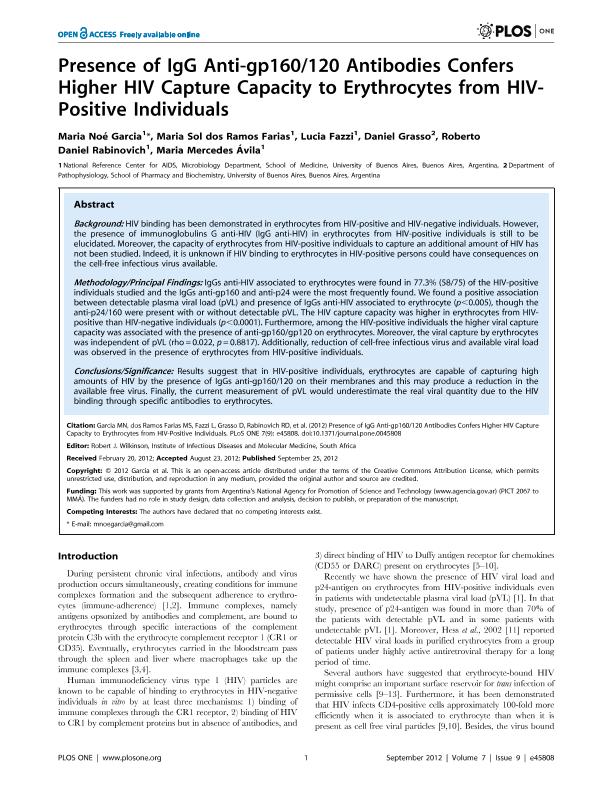Mostrar el registro sencillo del ítem
dc.contributor.author
Garcia, Maria Noe

dc.contributor.author
Dos Ramos Farías, María Sol

dc.contributor.author
Fazzi, Lucia

dc.contributor.author
Grasso, Daniel Hector

dc.contributor.author
Rabinovich, Roberto Daniel

dc.contributor.author
Avila, Maria Mercedes

dc.date.available
2017-05-15T22:12:27Z
dc.date.issued
2012-09
dc.identifier.citation
Garcia, Maria Noe; Dos Ramos Farías, María Sol; Fazzi, Lucia; Grasso, Daniel Hector; Rabinovich, Roberto Daniel; et al.; Presence of IgG anti-gp160/120 antibodies confers higher HIV capture capacity to erythrocytes from HIV-positive individuals; Public Library of Science; Plos One; 7; 9; 9-2012; e45808
dc.identifier.issn
1932-6203
dc.identifier.uri
http://hdl.handle.net/11336/16523
dc.description.abstract
Background: HIV binding has been demonstrated in erythrocytes from HIV-positive and HIV-negative individuals. However, the presence of immunoglobulins G anti-HIV (IgG anti-HIV) in erythrocytes from HIV-positive individuals is still to be elucidated. Moreover, the capacity of erythrocytes from HIV-positive individuals to capture an additional amount of HIV has not been studied. Indeed, it is unknown if HIV binding to erythrocytes in HIV-positive persons could have consequences on the cell-free infectious virus available. Methodology/Principal Findings: IgGs anti-HIV associated to erythrocytes were found in 77.3% (58/75) of the HIV-positive individuals studied and the IgGs anti-gp160 and anti-p24 were the most frequently found. We found a positive association between detectable plasma viral load (pVL) and presence of IgGs anti-HIV associated to erythrocyte (p<0.005), though the anti-p24/160 were present with or without detectable pVL. The HIV capture capacity was higher in erythrocytes from HIV-positive than HIV-negative individuals (p<0.0001). Furthermore, among the HIV-positive individuals the higher viral capture capacity was associated with the presence of anti-gp160/gp120 on erythrocytes. Moreover, the viral capture by erythrocytes was independent of pVL (rho = 0.022, p = 0.8817). Additionally, reduction of cell-free infectious virus and available viral load was observed in the presence of erythrocytes from HIV-positive individuals. Conclusions/Significance: Results suggest that in HIV-positive individuals, erythrocytes are capable of capturing high amounts of HIV by the presence of IgGs anti-gp160/120 on their membranes and this may produce a reduction in the available free virus. Finally, the current measurement of pVL would underestimate the real viral quantity due to the HIV binding through specific antibodies to erythrocytes.
dc.format
application/pdf
dc.language.iso
eng
dc.publisher
Public Library of Science

dc.rights
info:eu-repo/semantics/openAccess
dc.rights.uri
https://creativecommons.org/licenses/by-nc-sa/2.5/ar/
dc.subject
Hiv
dc.subject
Erythrocytes
dc.subject
Igg Anti-Hiv
dc.subject
Viral Capture
dc.subject.classification
Otras Medicina Básica

dc.subject.classification
Medicina Básica

dc.subject.classification
CIENCIAS MÉDICAS Y DE LA SALUD

dc.title
Presence of IgG anti-gp160/120 antibodies confers higher HIV capture capacity to erythrocytes from HIV-positive individuals
dc.type
info:eu-repo/semantics/article
dc.type
info:ar-repo/semantics/artículo
dc.type
info:eu-repo/semantics/publishedVersion
dc.date.updated
2017-05-15T14:44:01Z
dc.journal.volume
7
dc.journal.number
9
dc.journal.pagination
e45808
dc.journal.pais
Estados Unidos

dc.journal.ciudad
San Francisco
dc.description.fil
Fil: Garcia, Maria Noe. Universidad de Buenos Aires. Facultad de Medicina. Departamento de Microbiología. Centro Nacional de Referencia para el Sida; Argentina. Consejo Nacional de Investigaciones Científicas y Técnicas; Argentina
dc.description.fil
Fil: Dos Ramos Farías, María Sol. Universidad de Buenos Aires. Facultad de Medicina. Departamento de Microbiología. Centro Nacional de Referencia para el Sida; Argentina. Consejo Nacional de Investigaciones Científicas y Técnicas; Argentina
dc.description.fil
Fil: Fazzi, Lucia. Universidad de Buenos Aires. Facultad de Medicina. Departamento de Microbiología. Centro Nacional de Referencia para el Sida; Argentina. Consejo Nacional de Investigaciones Científicas y Técnicas; Argentina
dc.description.fil
Fil: Grasso, Daniel Hector. Universidad de Buenos Aires. Facultad de Farmacia y Bioquímica; Argentina. Consejo Nacional de Investigaciones Científicas y Técnicas; Argentina
dc.description.fil
Fil: Rabinovich, Roberto Daniel. Universidad de Buenos Aires. Facultad de Medicina. Departamento de Microbiología. Centro Nacional de Referencia para el Sida; Argentina. Consejo Nacional de Investigaciones Científicas y Técnicas; Argentina
dc.description.fil
Fil: Avila, Maria Mercedes. Universidad de Buenos Aires. Facultad de Medicina. Departamento de Microbiología. Centro Nacional de Referencia para el Sida; Argentina. Consejo Nacional de Investigaciones Científicas y Técnicas; Argentina
dc.journal.title
Plos One

dc.relation.alternativeid
info:eu-repo/semantics/altIdentifier/url/http://journals.plos.org/plosone/article?id=10.1371/journal.pone.0045808
dc.relation.alternativeid
info:eu-repo/semantics/altIdentifier/doi/http://dx.doi.org/10.1371/journal.pone.0045808
Archivos asociados
